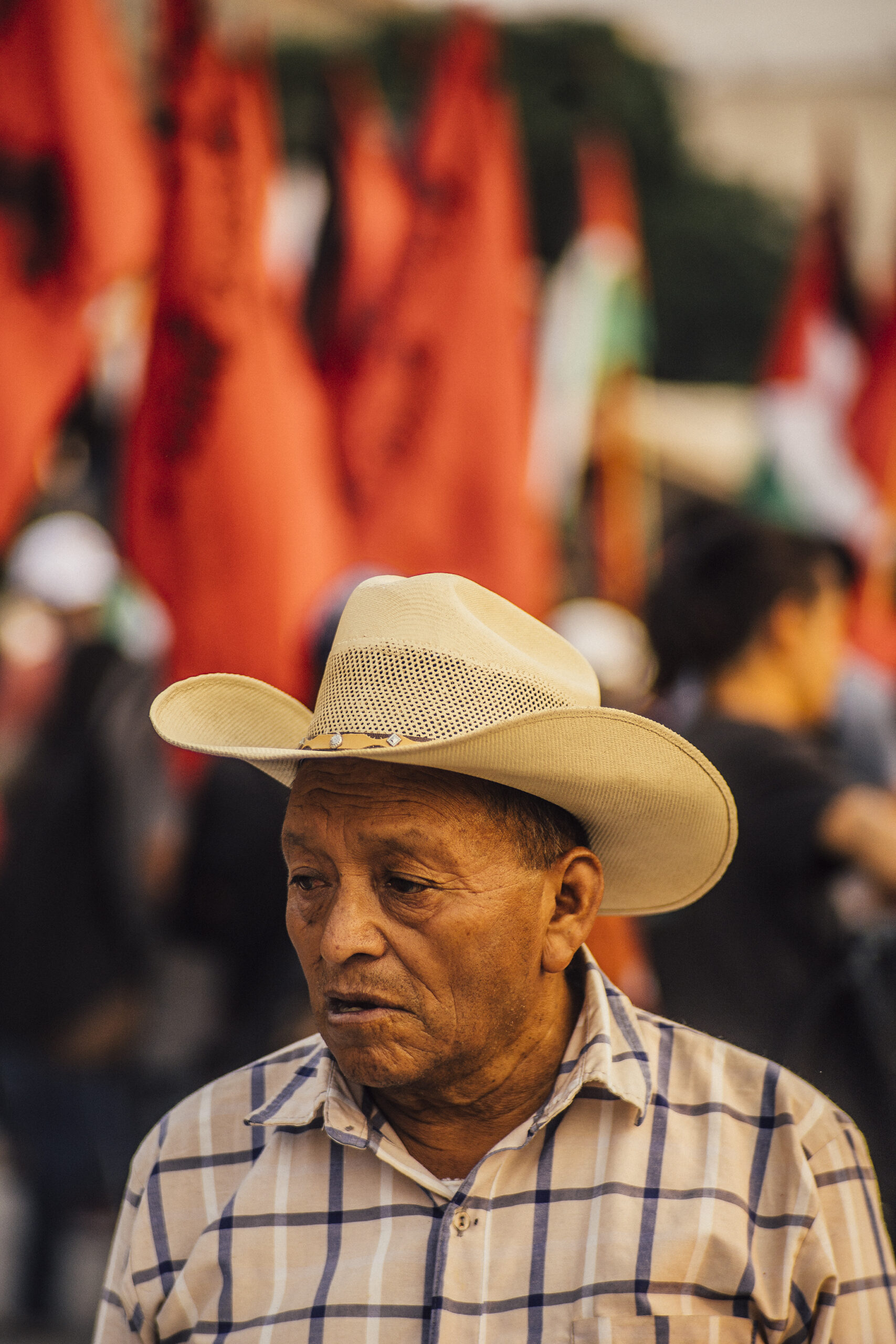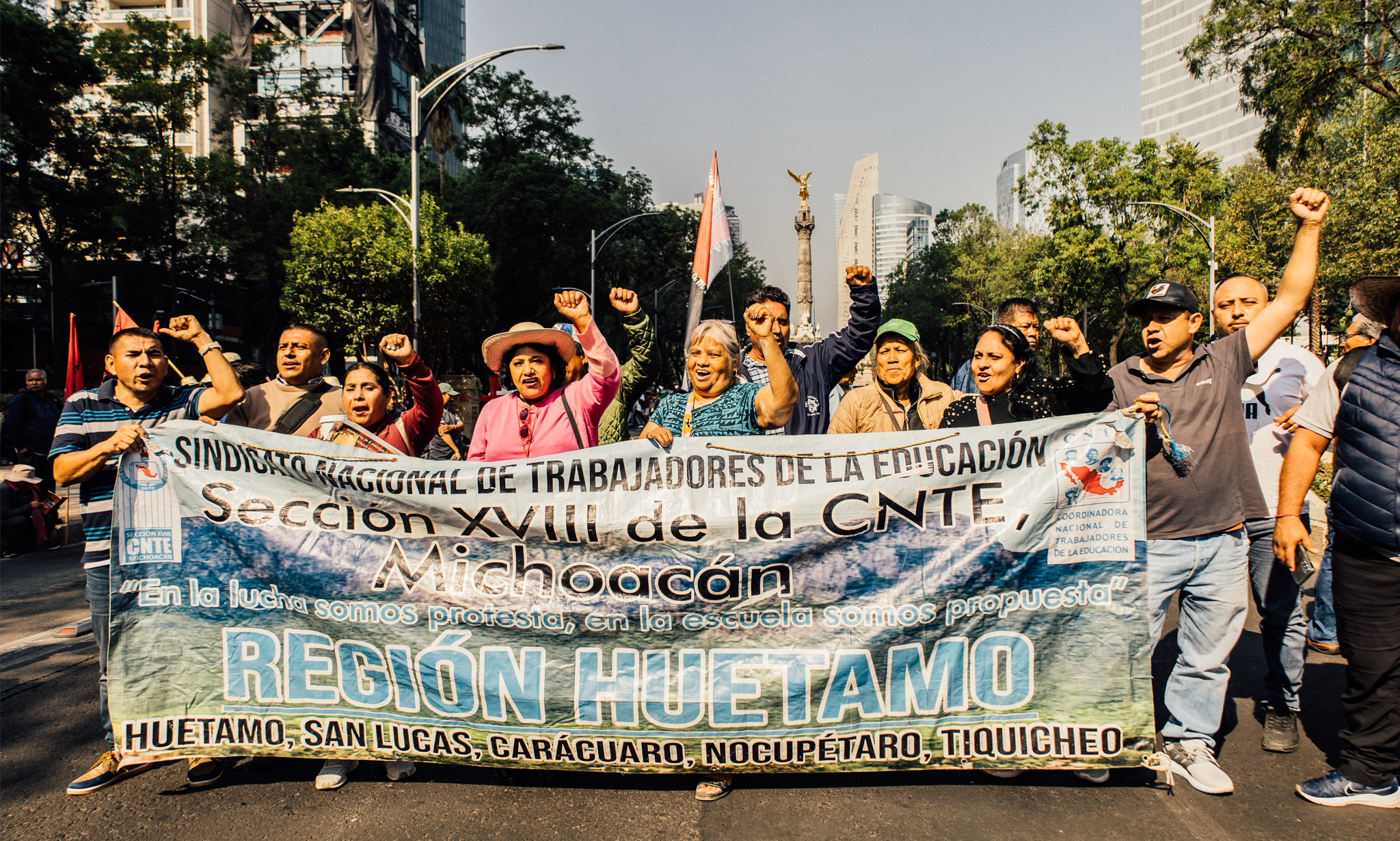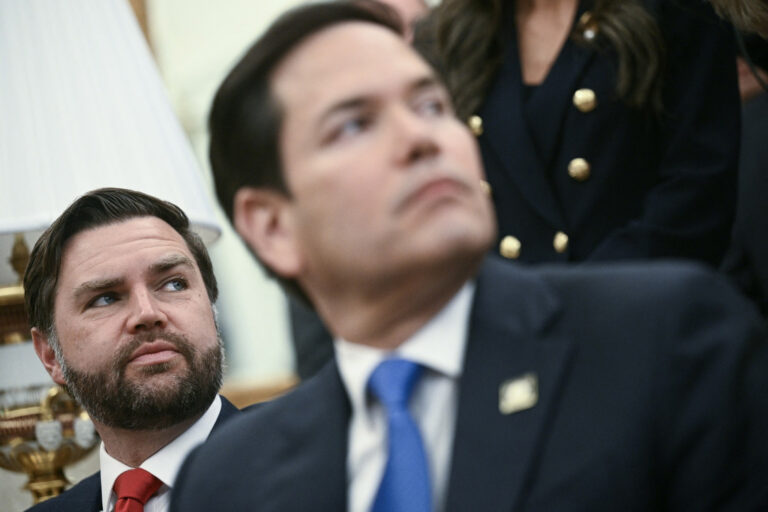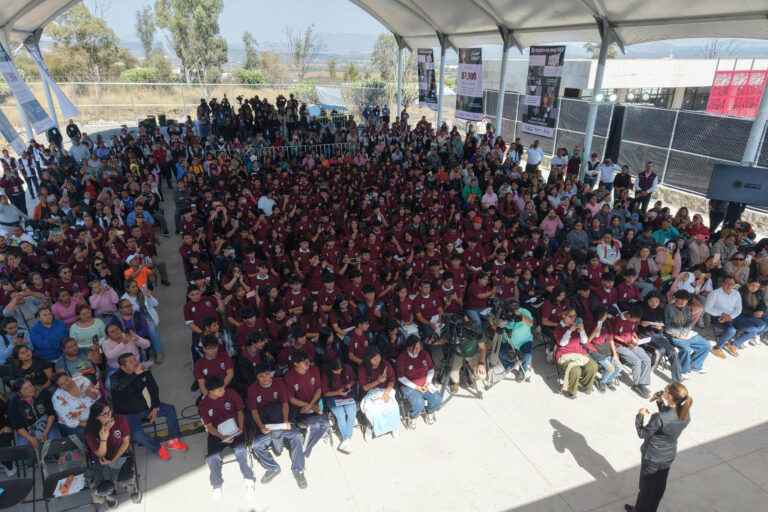Teachers In the Streets
Mexico’s relationship with its teachers is special, dating back to before the Mexican Revolution. Mexico was then mostly rural, and teachers were among the few who could read and write. Along with priests, they were the most respected members of their communities, often consulted when problems arose. They even acted as advisors to secular and military leaders.
As Mexico City teacher Angel Custodio tells us, teachers greatly influenced the 1917 constitution. Because they spent so much time with students and their families, they knew intimately that beyond reading, writing and arithmetic, the Mexican people needed rights and protections to secure their basic needs. With this perspective, they injected a social justice agenda into the constitution. In appreciation, on May 15, 1918, the first annual Teachers Day was organized.
But you can’t eat appreciation! Today, from their low pay and benefits, you’d never imagine the vital role teachers have played in Mexican communities. This year on Teachers Day, the CNTE, the militant pro-democratic caucus within the conservative SNTE, marched in the streets — and turned celebration into a demonstration, which is still ongoing.
The current CNTE demands are no less than the cutting edge of progressive efforts to dismantle the neoliberal rules that privatized social goods — in this case, public worker pensions. Teachers are demanding a return to the socialized pension system, which guaranteed stable and predictable retirement income based on a worker’s salary. They want the pension money taken out of the hands of private money managers, who can’t lose money themselves when they gamble with the worker’s dollars.
Yes, the Morena government has done a lot to reverse privatization, for example in the energy sector. But it’s time to work with the teachers to renationalize the pension system, and ensure educators get to enjoy the secure old age that they so richly deserve.

Ángel Custodio Guadarrama has been a research professor at Mexico City’s Institute of Higher Secondary Education since 2009. He is currently a member of the Mexican section of the Trinational Coalition in Defense of Public Education, where, in conjunction with teacher unions and movement organizations, he develops policies to prevent the privatization of public education services. He has a long history of union and social protest and is a member of the IEMA Workers’ Union (representing Mexico City preparatory schools), where he teaches history.
The role of teachers in Mexico’s history is unique, isn’t it?
Teachers have a foundational role in Mexican history and were directly involved in the formation of the Mexican state. Many were anarcho-syndicalists and socialists; the fact that social issues and worker rights were included in the 1917 Mexican Constitution is thanks to the teachers who helped write it.
The people have always had extreme respect for teachers, and the importance of education is embedded in that Constitution. Free public education from preschool through college was guaranteed to children and youth.
Did the teachers’ union carry on that progressive legacy?
In the 1930s, progressive president Lázaro Cárdenas brought all sectors of society, including labor, under the wing of the governing PRI party; labor leaders were appointed, not elected. Teachers were placed in the National Union of Education Workers, or SNTE. It’s the largest union in Latin America, with over 1.4 million members.

Like most unions, the SNTE operated as a state instrument. Its leaders exerted control over the teachers rather than fighting for them. Teachers who wanted a worker-run union responded in 1979 by forming the National Coordination of Education Workers, the CNTE, as a dissident caucus within the SNTE. The CNTE’s strongholds are in the states of Michoacán, Guerrero, Chiapas, Veracruz, and particularly Oaxaca, but it has gained significant strength in Baja California and Zacatecas.
Almost yearly, the CNTE has mounted campaigns to improve the lives of teachers and the communities they work in — militant campaigns including strikes, demonstrations, blocking highways — and has been met with extreme repression. Numbers of teachers lost their lives or were disappeared when the police and the military broke up their actions. That said, their confrontational tactics have produced most of the teachers’ gains.

A shift in education came with the advent of neoliberal economics. What were the proposed changes and the results?
Neoliberal “reforms” started even before NAFTA. That is, the idea that private enterprise could provide better services and provide them more efficiently than the public sector evolved into the dominant consensus. In the 1980s, Mexico moved to end free education in public colleges. I was part of the huge student movement that rose up in protest. We defeated that attempt. When NAFTA passed in 1994, the government proposed to end free university education again. Students rose up and defeated that effort too!
But after that, US-style neoliberalism became the order of the day, and public sector workers’ rights and benefits were eroded. In 2007, the pension system under the ISSSTE, the government department responsible for social security and social services for government employees, was converted from a solidarity-based system to individual retirement accounts. In the solidarity system, workers and government funded a large pool, and every worker could count on getting a defined percentage of their current pay. In the new system, based on private investment schemes, it’s possible that some retirees receive only about 30% of their usual pay, not a living wage.
Taking pension money from private banks and depositing it in the public bank would build a strong public banking sector, providing better services to ordinary people, not just the wealthy.
Currently, the size of the public sector pension fund is massive. Yesterday, Professor Pedro Hernández, a CNTE general secretary, reported that workers’ savings deposited in the AFOREs, or Income Savings Funds, total 8.2 trillion pesos, equivalent to just over US $420 billion! AFOREs, private companies that manage the individual accounts, invest that money and earn large profits for finance capital.
In President Peña-Nieto’s 2012-2018 term, teachers’ job security and the quality of education faced its biggest threat. He proposed that teachers keep their jobs or be fired based on how they performed on standardized tests. As if the test questions represented all the necessary competencies of a teacher! CNTE’s biggest victory was the defeat of those proposals.

On May 15, CNTE demonstrated in Mexico City’s Zócalo demanding an immediate improvement in their wages and retirement benefits. Has President Sheinbaum supported them?
First, the teachers don’t believe President Sheinbaum appreciates their worth. She’s offered a 9% raise with 1% more in September, but they demand 100%. Inflation has severely reduced the purchasing power of their wages. They’ve been underpaid for years and want to catch up.
Second, when she ran for president, Sheinbaum promised she would repeal the 2007 changes to the ISSSTE, but now in office, she so far hasn’t agreed to do that. Nor has she agreed to take the pension funds out of the private banks. Hence, the slogan, “Are you with the teachers or with the banks?” Her one concession was not to raise the retirement age, as she had originally proposed.
All the teachers’ demands are justified. Moreover, repeal of the ISSSTE would not just benefit all public sector workers, but also all workers. Taking pension money from private banks and depositing it in the public bank would build a strong public banking sector, providing better services to ordinary people, not just the wealthy.

The CNTE doesn’t seem to have the mass support it has had in its past militant actions. Is that true?
In this contract struggle, the CNTE shut down the airport, blocked journalists from attending a Sheinbaum mañanera, and more — and the tactics have created some backlash. Also, the CNTE nucleus that determines their tactics is from the Oaxaca chapter; many other states participate, but without fully supporting them. For example, the leader of the CNTE’s Michoacán chapter is in Mexico City, but she hasn’t called for other members to join her. She’s encouraging them to negotiate with their local officials as Sheinbaum has also suggested.
CNTE’s problem is that many who took to the streets against President Peña-Nieto before 2018 are now with AMLO and Sheinbaum. In addition, AMLO instituted the New Mexican School model, a teaching methodology based on traditional Indigenous practices. Rather than teaching success for individuals, they teach competencies that promote the collective good. This reform also undercut support for the CNTE’s actions. The teachers encamped in the Zócalo don’t currently represent the majority of teachers.
In parallel to the CNTE’s struggle, my own union, the SUTIEMS which represents teachers in the High School Education Institute of Mexico City, began striking on Thursday, June 5. We demand a 30% salary increase, plus hiring sufficient administrative and teaching staff to properly serve our students. Mayor Clara Brugada Molina has offered the 1,800 education workers a mere 3.5%, while offering the 80,000-member police force 9%!
The teachers’ demands are legitimate, and they challenge bourgeois ideas and their profits. The question is not “if” they should challenge them, but “how!” Many support their demands, but not their tactics. I and many other educators are involved in discussions about the “how.” We think that teachers can and must play a role as a respected constituency, as they did in 1917, when their beliefs shaped a progressive Constitution.
-
The Poor as Instruments, Not Allies
Welfare programs with political aims are not the same as forging political alliances with the impoverished population created by voracious neoliberal capitalism.
-
Florida, the Race for the Presidency & Opaque Capital
Contemporary Florida is the distorted and advanced mirror of a new form of global governance, where money laundering has not only been tolerated, but institutionalized & updated for the digital age, fed by a murky river flowing from the Global South.
-
People’s Mañanera December 22
President Sheinbaum’s daily press conference, with comments on economic achievements, Sonora development plan, extortion of immigrants, Baja California Sur dam, water treaty with US, nepotism loopholes, and García Luna.




